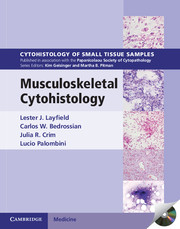Book contents
- Frontmatter
- Contents
- 1 Principles and practice for biopsy diagnosis and management of musculoskeletal lesions
- 2 Ancillary techniques useful in the evaluation and diagnosis of bone and soft tissue neoplasms
- 3 Spindle cell tumors of bone and soft tissue in infants and children
- 4 Spindle cell tumors of the musculoskeletal system characteristically occurring in adults
- 5 Giant cell tumors of the musculoskeletal system
- 6 Myxoid lesions of bone and soft tissue
- 7 Lipomatous tumors
- 8 Vascular tumors of bone and soft tissue
- 9 Pleomorphic sarcomas of bone and soft tissue
- 10 Osseous tumors of bone and soft tissue
- 11 Cartilaginous neoplasms of bone and soft tissue
- 12 Small round cell neoplasms of bone and soft tissue
- 13 Epithelioid and polygonal cell tumors of bone and soft tissue
- 14 Cystic lesions of bone and soft tissue
- Index
10 - Osseous tumors of bone and soft tissue
Published online by Cambridge University Press: 05 September 2013
- Frontmatter
- Contents
- 1 Principles and practice for biopsy diagnosis and management of musculoskeletal lesions
- 2 Ancillary techniques useful in the evaluation and diagnosis of bone and soft tissue neoplasms
- 3 Spindle cell tumors of bone and soft tissue in infants and children
- 4 Spindle cell tumors of the musculoskeletal system characteristically occurring in adults
- 5 Giant cell tumors of the musculoskeletal system
- 6 Myxoid lesions of bone and soft tissue
- 7 Lipomatous tumors
- 8 Vascular tumors of bone and soft tissue
- 9 Pleomorphic sarcomas of bone and soft tissue
- 10 Osseous tumors of bone and soft tissue
- 11 Cartilaginous neoplasms of bone and soft tissue
- 12 Small round cell neoplasms of bone and soft tissue
- 13 Epithelioid and polygonal cell tumors of bone and soft tissue
- 14 Cystic lesions of bone and soft tissue
- Index
Summary
INTRODUCTION
Neoplastic and non-neoplastic bone forming lesions are found within both the soft tissues (especially muscles and joints) and bones. Aspiration biopsy of heavily ossified lesions generally results in extremely hypocellular or acellular aspirates and in these cases, small core biopsy may also be unsuccessful.
Heterotopic bone may be found as a metaplastic product in both neoplastic and non-neoplastic lesions. Aspiration samples of heterotopic ossification usually yield hypocellular smears or at most reactive fibroblasts scattered in a bloody background. Morphologically dissimilar but potentially etiologically related are aspirates of dystrophic calcification. Both lesions can reach massive size and are frequently found in periarticular areas particularly around the hip. Other lesions with non-neoplastic ectopic ossification include myositis ossificans and fibrodysplasia ossificans progressive.
MYOSITIS OSSIFICANS
Clinical features
Myositis ossificans is a benign bone forming proliferation of a reactive or reparative nature. It most commonly occurs in striated muscle but similar lesions are reported to occur in the subcutaneous tissues and tendons. Myositis ossificans is related to nodular and proliferative fasciitis but differs morphologically in that bone formation occurs with various degrees of maturation. Some authors subdivide myositis ossificans into traumatic and non-traumatic forms but this appears to have little if any clinical value. Many examples follow a traumatic incident and are often associated with pain and tenderness. Over a period of 2 to 3 weeks, the soft tissue swelling becomes increasingly localized and mass-like. With further time, the lesion becomes rock hard as true ossification develops. The masses average between 3 and 6 cm in greatest dimension.
- Type
- Chapter
- Information
- Musculoskeletal Cytohistology , pp. 198 - 219Publisher: Cambridge University PressPrint publication year: 2000

